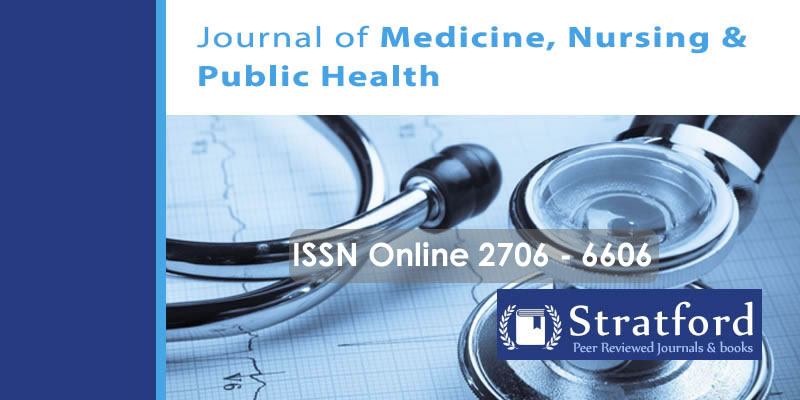Caregivers level of information and Access to Rehabilitation Therapy among Children with Disability, in West Bengal, India
Abstract
Poverty is a social condition characterized by the lack of resources necessary for basic survival or necessary to meet a certain minimum level of living standards. Thus, poverty affects ones’ general social functioning but to a great extent health care. The effects of poverty in families of children with disabilities are very grave. The purpose of this study was to determine the influence of caregivers’ level of information and caregivers’ education levels, have on access to rehabilitation therapy for their children with disabilities in West Bengal, India. The study adopted a cross-sectional methodology targeting 108 caregivers which indicated that traditional cultural beliefs influenced access to rehabilitation therapy for children with disabilities. Data analysis involved descriptive statistics. The specific descriptive statistics included means and standard deviations. Witchcraft topped among traditional beliefs that were perceived to cause disability among the children. Many were aware of the nature of their child’s disability and thus could seek rehabilitation therapy. The most common forms of disabilities according to the study was Cerebral Palsy and others like Autism, Paraplegia, Down Syndrome, Epilepsy, Club Feet, Mental Disability and Hydrocephalus also being recorded. Most caregivers had attained secondary level of education and primary education. With the level of education possibly implying level of awareness and understanding about the nature of disabilities, which further influence access to rehabilitation therapy. The study concludes that caregivers’ level of information influences access to rehabilitation therapy for children with disabilities. Awareness training may be through seminars, church announcements and media communication through radio, televisions and newspapers. Government through Ministry of Health of India could also embark in sensitizing residents of West Bengal on disabilities and available rehabilitation therapies for children.
Key words: Poverty, Rehabilitation Therapy, Children, Disabilities, West Bengal
References
Bright, T., Wallace, S., & Kuper, H. (2018). A systematic review of access to rehabilitation for people with disabilities in low-and middle-income countries. International journal of environmental research and public health, 15(10), 2165.
Bunning, K., Gona, J. K., Odera-Mung’ala, V., Newton, C. R., Geere, J. A., Hong, C. S., & Hartley, S. (2014). Survey of rehabilitation support for children 0–15 years in a rural part of Kenya. Disability and rehabilitation, 36(12), 1033-1041.
Doore, G. (1988). Shaman's Path: Healing, Personal Growth & Empowerment. Random House Incorporated.
Grech, S. (2016). Disability and development: Critical connections, gaps and contradictions. In Disability in the Global South (pp. 3-19). Springer, Cham.
Hussey, M., MacLachlan, M., & Mji, G. (2017). Barriers to the implementation of the health and rehabilitation articles of the United Nations convention on the rights of persons with disabilities in South Africa. International journal of health policy and management, 6(4), 207.
Kumar, S. G., Roy, G., & Kar, S. S. (2012). Disability and rehabilitation services in India: Issues and challenges. Journal of Family Medicine and Primary Care, 1(1), 69-73.
Landry, M. D., Rama, S. R., Harris, E., Madison, L., Parekh, M., Banks, C., ... & Wijesinghe, C. (2015). Exploring the factors that influence the perceptions of disability: a qualitative study of mothers of children with disabilities at a community-based rehabilitation centre in Sri Lanka. WHO South-East Asia journal of public health, 4(2), 150-158.
Levitt, J. M. (2017). Developing a model of disability that focuses on the actions of disabled people. Disability & Society, 32(5), 735-747.
Masasa, T. L. (2012). Cultural beliefs towards disability: their influence on rehabilitation (Doctoral dissertation, Stellenbosch: Stellenbosch University).
Mishra, K., & Siddharth, V. (2018). Factors influencing institutional-based pediatric rehabilitation services among caregivers of children with developmental delay in Southwestern Rajasthan. Journal of neurosciences in rural practice, 9(1), 36.
Mishra, K., & Siddharth, V. (2018). Factors influencing institutional-based pediatric rehabilitation services among caregivers of children with developmental delay in Southwestern Rajasthan. Journal of neurosciences in rural practice, 9(01), 036-041.
Morell, C. (2004). Empowerment theory and long-living women: A feminist and disability perspective. Journal of human behavior in the social environment, 7(3-4), 225-236.
National Sample Survey Organization (2017). A report on disabled persons. New Delhi: Department of Statistics, Government of India; 2017.
Porterfield, S. L., & McBride, T. D. (2017). The effect of poverty and caregiver education on perceived need and access to health services among children with special health care needs. American Journal of Public Health, 97(2), 323-329.
Rappaport, J. (2002). In praise of paradox: A social policy of empowerment over prevention. In A Quarter Century of Community Psychology (pp. 121-145). Boston, MA.: Springer.
Sechoaro, E. J., Scrooby, B., & Koen, D. P. (2014). The effects of rehabilitation on intellectually-disabled people-a systematic review. Health SA Gesondheid, 19(1).
Shearer, N. B. C. (2009). Health empowerment theory as a guide for practice. Geriatric nursing (New York, NY), 30(2 Suppl), 4.
Vadivelan, K., Sekar, P., Sruthi, S. S., & Gopichandran, V. (2020). Burden of caregivers of children with cerebral palsy: an intersectional analysis of gender, poverty, stigma, and public policy. BMC public health, 20, 1-8.
Weissberg, R. (1999). The politics of empowerment. Greenwood Publishing Group.
WHO, (2011), World Report on Disability, World Health Organisation, Geneva.
Zimmerman, M. A. (2000). Empowerment theory. In Handbook of community psychology (pp. 43-63).
Zimmerman, M. A., & Warschausky, S. (1998). Empowerment theory for rehabilitation research: Conceptual and methodological issues. Rehabilitation psychology, 43(1), 3.
Zuurmond, M. A., Mahmud, I., Polack, S., & Evans, J. (2015). Understanding the lives of caregivers of children with cerebral palsy in rural Bangladesh: Use of mixed methods. Original Research . Vol. 26, No.2, 2015; doi 10.5463/DCID.v26i2.414.


